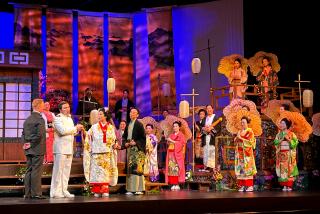‘Dido and Aeneas’ Admirable Yet Flawed
- Share via
Television can do two very good things for opera. It can document an exceptional evening in the theater, especially when a new work or a new concept for an old work is concerned. Or, and this is the more exciting alternative, it can use television creatively and produce opera made specifically for video. As Europeans know but Americans don’t, video opera has become a lively hybrid all its own.
But the opera that finds its way onto public television tends to do exactly what television is the weakest at, namely taking the viewer to an ordinary night at the Metropolitan Opera, as if a camera microscopically examining open-throated singers could replace real, visceral theater.
Tonight’s broadcast at 10 on KCET-TV Channel 28 of the made-for-television production of Henry Purcell’s “Dido and Aeneas,” long the most popular Baroque opera, is a welcome attempt at creative video opera. Would that it were a more successful one.
Filmed last year at Hampton Court, which Henry VIII built on the banks of the Thames in the early 16th century, the video moves the action from ancient Greek times to Purcell’s era, give or take a century and a half (the opera was composed in 1689).
The director, Peter Maniura, clearly thinks highly of Hampton Court and he uses the camera like a nervously roving eye, rarely stopping, catching the place from every angle. When the camera does stop, it is to leer, given that Maria Ewing (Dido) and the unshaven Karl Daymond (Aeneas) are a handsome pair.
There is nothing wrong with a little visual flair in opera; there is no reason to put opera on video without it. But here the camera seems frightened of the music, of catching the rhythm of the opera, of helping reveal a singer’s interpretation. It seems, instead, in a desperate hurry to escape the music’s hold.
The interpretations themselves are curiously ordinary--curious, especially, in the case of Ewing, given what a bizarre singer the soprano has become. There is little of the extreme mugging and quirky movements that she adapts in the theater, occasionally to hilariously wrong effect but often in the cause of potent drama.
Here Ewing simply looks and sounds off-kilter. But then again, synchronization between mouth and word was separated by a second or two on the review tape; it also smeared her lipstick and its sound made her normally rich, milky tone bright and brittle.
No one in the cast fared well on this tape, especially not the period orchestra, conducted by Richard Hickox. The quality of the audio brought to mind Sir Thomas Beacham’s famous quip comparing the sound of a harpsichord to two skeletons copulating on a tin roof.
Presumably tonight’s broadcast will correct those flaws and may even be a pleasure rather than a trial to watch. But such problems also reveal just how careless PBS can be when it comes to opera, however glad it is to let the Three Tenors hold out its fund-raising cup.
* “Dido and Aeneas” airs on “Great Performances” at 10 tonight on KCET-TV Channel 28.
More to Read
The biggest entertainment stories
Get our big stories about Hollywood, film, television, music, arts, culture and more right in your inbox as soon as they publish.
You may occasionally receive promotional content from the Los Angeles Times.











